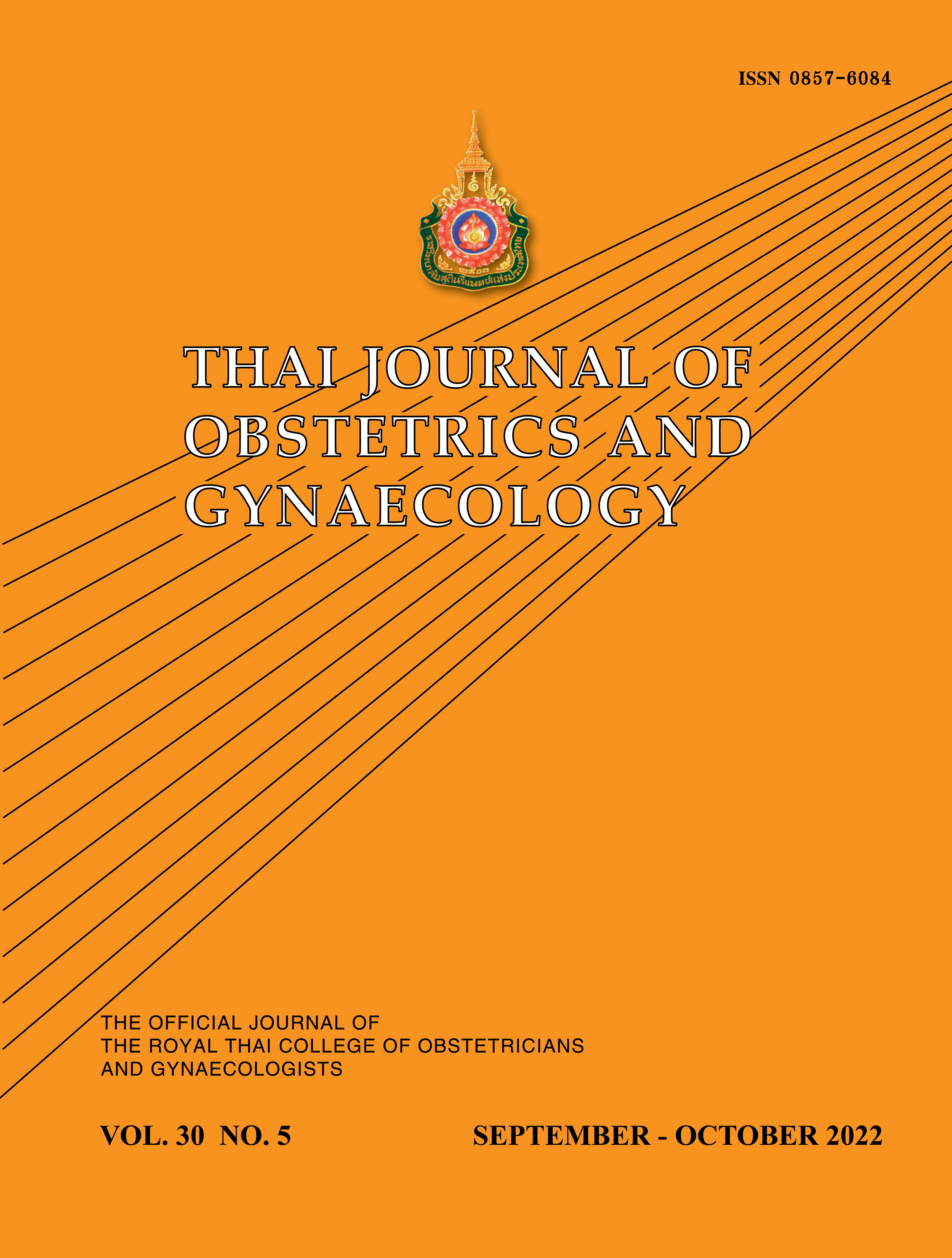Uterocervical Angle Measurement for Prediction Spontaneous Preterm Birth in Twin Pregnancy
Main Article Content
Abstract
Objective: This study's objective determined the predictive value of the uterocervical angle in predicting preterm birth in twin pregnant women at 16-23+6 weeks of gestation.
Material and Method: A diagnostic study was conducted in twin pregnant women at 16-23+6 weeks of gestation who had prenatal care at the King Chulalongkorn Memorial Hospital between March 2019 and February 2020. Uterocervical angle and cervical length were assessed at 16-23+6 weeks of gestation. Optimal cutoff for the uterocervical angle was obtained to calculate the predictive values for preterm birth.
Results: A total of 84 pregnant women were included in this study. Thirty-eight cases (47.5%) developed preterm birth. Women who delivered < 37 weeks had significantly higher uterocervical angles compared to those who delivered > 37 weeks (109.32 degrees vs. 96.41 degrees, P=0.016). The optimal cutoff of the uterocervical angle was 102 degrees. Sensitivity specificity, positive predictive value, and negative predictive value were 65.8%, 61.9%, 61.9%, and 68.4%, respectively.
Conclusion: The uterocervical angle is an easy technique that can be one of the screening tools to predict preterm birth among twin pregnant women who had an angle equal to or greater than 102 o, with a sensitivity, positive predictive value, and a negative predictive value of more than 60%.
Article Details

This work is licensed under a Creative Commons Attribution-NonCommercial-NoDerivatives 4.0 International License.
References
Committee on Practice Bulletins Obstetrics, Society for Maternal-Fetal Medicine. Multifetal Gestations: Twin, triplet, and higher-order multifetal pregnancies. Practice Bulletin No.169. Obstet Gynecol 2016;128:131-46.
National Collaborating Centre for Women’s and Children’s Health. Multiple pregnancy: the management of twin and triplet pregnancies in the antenatal period. NICE Clinical Guideline. RCOG Press 2011.
Suriya N, Yuthavisuthi P. Pregnancy and perinatal outcomes of twin pregnancies in Prapokklao Hospital. Thai J Obstet Gynaecol 2010;18:165-71.
Fuchs F, Senat MV. Multiple gestations and preterm birth. Semin Fetal Neonatal Med 2016;21:113-20.
Department of Obstetrics and Gynecology, Faculty of Medicine, Chulalongkorn University Statistical report 2011-2015.
Gibson JL, Macara LM, Owen P, Young D, Macauley J, Mackenzie F. Prediction of preterm delivery in twin pregnancy: a prospective, observational study of cervical length and fetal fibronectin testing. Ultrasound Obstet Gynecol 2004;23:561-6.
Yang JH, Kuhlman K, Daly S, Berghella V. Prediction of preterm birth by second trimester cervical sonography in twin pregnancies. Ultrasound Obstet Gynecol 2000;15:288-91.
Klein K, Gregor H, Hirtenlehner-Ferber K, Stammler-Safar M, Witt A, Hanslik A, et al. Prediction of spontaneous preterm delivery in twin pregnancies by cervical length at mid-gestation. Twin Res Hum Genet 2008;11:552-7.
Conde-Agudelo A, Romero R, Hassan SS, Yeo L. Transvaginal sonographic cervical length for the prediction of spontaneous preterm birth in twin pregnancies: a systematic review and meta-analysis. Am J Obstet Gynecol 2010;203:128.e1-12.
Asnafi N, Basirat Z, Hajian-Tilaki K, Dadvar S. Assessment of cervical length by transvaginal ultrasonography to predict preterm delivery in twin pregnancy. J Matern Fetal Neonatal Med 2013;26:1435-8.
Guzman ER, Walters C, O’reilly-Green C, Kinzler WL, Waldron R, Nigam J, et al. Use of cervical ultrasonography in prediction of spontaneous preterm birth in twin gestations. Am J Obstet Gynecol 2000;183:1103-7.
House M, McCabe R, Socrate S. Using imaging-based, three-dimensional models of the cervix and uterus for studies of cervical changes during pregnancy. Clin Anat 2013;26: 97-104.
Myers KM, Feltovich H, Mazza E, Vink J, Bajka M, Wapner RJ, et al. The mechanical role of the cervix in pregnancy. J Biomech 2015;48:1511-23.
Fernandez M, House M, Jambawalikar S, Zork N, Vink J, Wapner R, et al. Investigating the mechanical function of the cervix during pregnancy using finite element models derived from high-resolution 3D MRI. Comput Methods Biomech Biomed Engin 2016;19:404-17.
Sochacki-Wojicicka N, Wojcicki J, Bomba-Opon D, Wielgos M. Anterior cervical angle as a new biophysical ultrasound marker for prediction of spontaneous preterm birth. Ultrasound Obstet Gynecol 2015 ;46:377-8.
Arabin B, Alfirevic Z. Cervical pessaries for prevention of spontaneous preterm birth: past, present and future. Ultrasound Obstet Gynecol 2013;42:390-9.
Dziadosz M, Bennett TA, Dolin C, West Honart A, Pham A, Lee SS, et al. Uterocervical angle: a novel ultrasound screening tool to predict spontaneous preterm birth. Am J Obstet Gynecol 2016;215:376.e1-7.
Knight JC, Tenbrink E, Onslow M, Patil AS. Uterocervical angle measurement improves prediction of preterm birth in twin gestation. Am J Perinatol 2018;35:648-54.
Kagan KO, Sonek J. How to measure cervical length. Ultrasound Obstet Gynecol 2015;45:358-62.
Iams JD, Grobman WA, Lozitska A, Spon CY, Saade G, Mercer BM, et al. Eunice Kennedy Shriver National Institute of Child Health and Human Development Maternal–Fetal Medicine Units Network. Adherence to criteria for transvaginal ultrasound imaging and measurement of cervical length. Am J Obstet Gynecol 2013;209:365.e1-5
Peixoto AB, da Cunha Caldas TMR, Tahan LA, Petrini CG, Martins WP, Costa FDS, et al. Second trimester cervical length measurement for prediction spontaneous preterm birth in an unselected risk population. Obstet Gynecol Sci 2017;60:329-35.
Committee on Practice Bulletins - Obstetrics, The American College of Obstetricians and Gynecologists. Practice bulletin no. 130: prediction and prevention of preterm birth. Obstet Gynecol 2012;120:964-73.
Hester AE, Ankumah NE, Chauhan SP, Blackwell SC, Sibai BM. Twin transvaginal cervical length at 16-20 weeks and prediction of preterm birth. J Matern Fetal Neonatal Med 2019;32:550-4.


